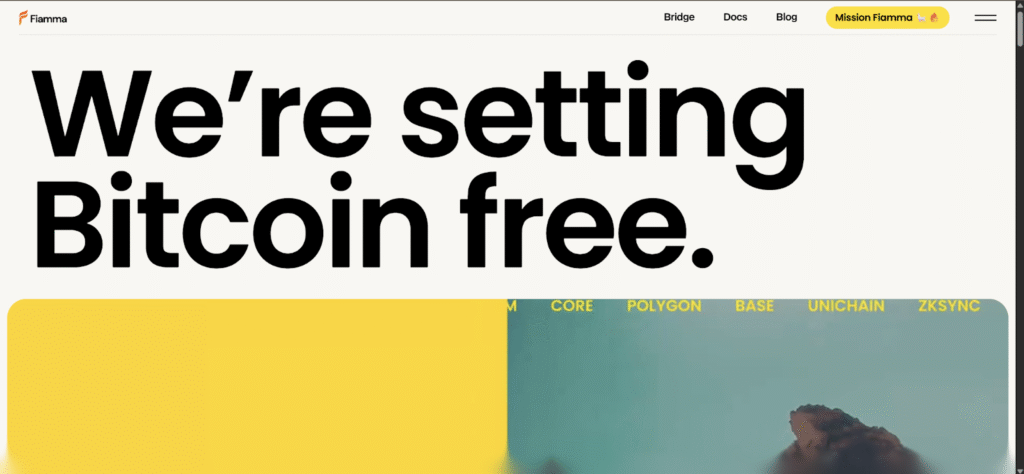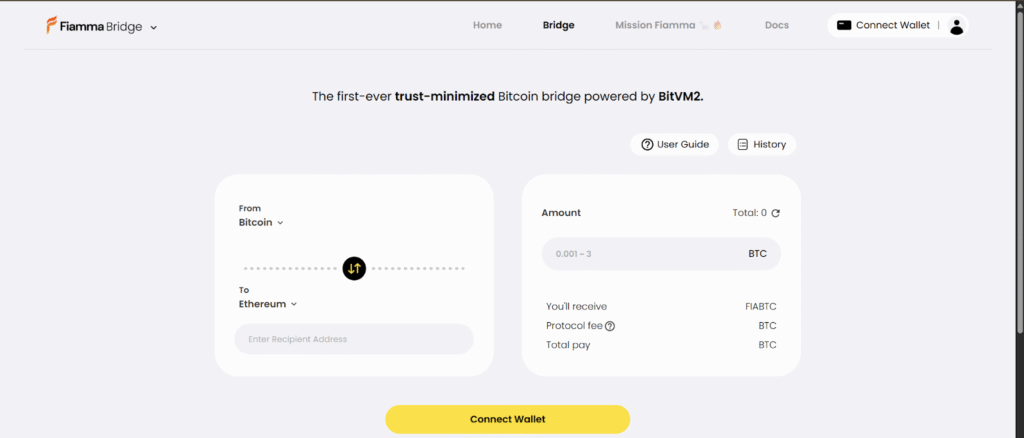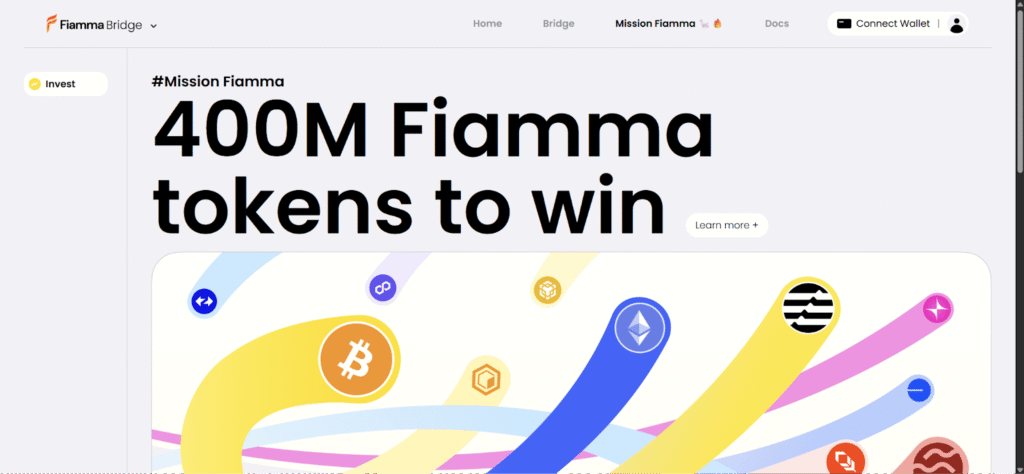Bitcoin has long been recognised as the foundation of decentralised finance, yet it has also been limited in one crucial aspect, which is programmability.
While billions of dollars of BTC sit idle, the demand for trust-minimised access to decentralised finance, real-world assets, and cross-chain applications has only grown.
Fiamma steps in to address this gap, introducing a way for Bitcoin itself to verify zero-knowledge proofs optimistically through BitVM2. This innovation creates an environment where BTC can move securely across chains without relying on custodians or fragile multisig systems.
The following sections explain what Fiamma is, how it works, its products, and the reward programmes attached to its launch.
What is Fiamma?
Fiamma is a project designed to make Bitcoin more than just a store of value. Its central aim is to enable BTC holders to use their assets across decentralised finance, credit markets, and real-world applications, all without surrendering custody or trust to intermediaries.

The team behind Fiamma is composed of cryptographers, blockchain developers, and fintech professionals who are pioneering BitVM2, or the second version of the Bitcoin Virtual Machine.
At the core of Fiamma is its bridge, which allows users to mint a token called FiaBTC. This token is pegged one-to-one with native BTC, giving holders the ability to trade, borrow, or earn yield across multiple ecosystems while keeping their original Bitcoin secured on-chain.
The bridge is not just another custodial mechanism. Instead, it relies on Bitcoin itself as the final arbiter for verifying zero-knowledge proofs and handling disputes.
Unlike traditional bridges, which often rely on centralised multisig committees that have been vulnerable to hacks, Fiamma employs what it calls Isolated Safe Architecture.
This structure means each user’s BTC is placed in a personal vault, jointly controlled by the user and the bridge committee.
For an attacker to compromise all funds, they would need to breach every vault individually, which is practically impossible. By combining this approach with optimised zero-knowledge verification, Fiamma provides a far more resilient infrastructure for bridging.
How Does It Enable Zero-Knowledge Proofing Optimistically?
The challenge with Bitcoin has always been that its scripting system is limited compared to other blockchains like Ethereum. This makes it difficult to build sophisticated applications or even to verify advanced cryptographic proofs directly on the network.

Fiamma tackles this by integrating BitVM2, which allows Bitcoin to perform fragmented zero-knowledge verification through its script.
In practice, this means that when BTC is bridged, proofs of correctness are created and verified optimistically. The default assumption is that everything is valid, but anyone can challenge the process if something looks suspicious.
These challenges are handled directly on Bitcoin through Taproot logic and on-chain fraud-proof resolution. As long as there is at least one honest participant in the network of challengers, malicious activity can be detected and punished.
The design also addresses scalability. Traditional zero-knowledge verifiers on Bitcoin would require large transactions that could be difficult to process.
Fiamma has developed compact verifiers that keep the challenge size under 400 kilobytes, which allows the process to run smoothly without relying on specific mining pools or external support.
This combination of efficiency and security makes it possible for BTC to become a programmable and interoperable asset without compromising its decentralised ethos.
What are Its Products?
Fiamma’s ecosystem begins with the Fiamma Bridge, its flagship product. The bridge allows users to convert native BTC into FiaBTC, which can then be used across supported blockchains.

At launch, the bridge already supports eleven different chains, including Ethereum, Solana, Aptos, BNB Chain, and others. The bridge has been tested extensively, with more than 300,000 users interacting during the testnet phase and over six million transactions processed.
The bridge is designed with three pillars in mind. First, it is non-custodial, meaning users never have to hand over full control of their BTC.
Second, it is hack-resistant through its Isolated Safe Architecture, ensuring funds cannot be drained en masse. Third, it is maximally trust-minimised, with permissionless challenges reducing reliance on committees to almost zero.
Together, these features mark a departure from the fragile multisig systems that have historically plagued cross-chain infrastructure.
Beyond the bridge, Fiamma is preparing to launch Fiamma One, a superapp focused on making Bitcoin earning effortless.
This application will allow users to generate yield from BTC or stablecoins with a single click. It is designed to improve accessibility by removing the complexity usually associated with non-custodial strategies.
Through Fiamma One, Bitcoin holders will be able to explore non-custodial lending, stablecoin strategies, and real-world asset integrations securely.
Importantly, Fiamma has not yet released a native token. Instead, its products currently revolve around FiaBTC, the pegged token minted through the bridge, and upcoming campaigns aimed at rewarding early adopters.
Rewards and Campaigns
To encourage participation, Fiamma has launched a programme called Mission Fiamma, which is designed to reward users for engaging with the bridge and its ecosystem. The campaign is divided into several missions that provide different ways to earn points, referred to as Alpaca Points.

The first mission is minting. By minting FiaBTC, users earn points and unlock eligibility for further campaigns. The second mission is holding, where users gain additional points simply by holding FiaBTC over time on supported chains such as Aptos and Sei.
The third mission involves using FiaBTC in DeFi applications. By depositing FiaBTC into protocols like Hyperion, Takara Lend, or Yaka Finance, users can earn monthly rewards, making active participation more lucrative.
To make these missions more engaging, Fiamma has added multipliers and bonuses. For example, the earliest minters benefit from an eight-times multiplier on their points if they participate before the total minted volume crosses ten BTC. Later stages offer lower multipliers, but still reward early engagement compared to waiting.
Additional boosts are offered for using partner codes, with up to 30% more points available during the first week.
Referral campaigns are also in place. By inviting friends to mint and participate, users can earn 10% of the points their invitees collect, creating a community-driven incentive structure.
However, points can be reduced if users withdraw BTC too early, with a 50% penalty applied for withdrawals within the first three months. This design encourages long-term commitment and stability in the bridge’s growth.
Alongside these structured missions, ecosystem incentives offer yields ranging from four to over 30%. This is made possible through collaborations with DeFi partners and liquidity providers, ensuring that rewards remain competitive for users seeking sustainable yield.
Fiamma has also organised community challenges, such as writing contests and creative campaigns, which give participants a chance to win spotlight opportunities and additional rewards.
The reward system is designed not just to provide financial incentives but to build a strong base of users who actively contribute to the growth and testing of Fiamma’s infrastructure.
By aligning rewards with responsible usage and ecosystem engagement, Fiamma seeks to grow both securely and sustainably.
Conclusion
Fiamma represents a significant step forward for Bitcoin’s role in decentralised finance. By enabling Bitcoin itself to verify zero-knowledge proofs optimistically, it removes the need for custodians or fragile multisig systems that have failed in the past.
Its flagship product, the Fiamma Bridge, introduces a secure and trust-minimised way to mint and use BTC across multiple chains, while the upcoming Fiamma One superapp promises to simplify yield generation for everyday users.
With its mission campaigns and rewards, Fiamma is building a community around active participation. Although there is no native token yet, the groundwork being laid suggests that Bitcoin is closer than ever to becoming fully interoperable and programmable.

